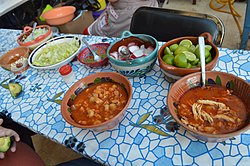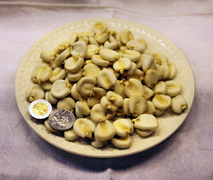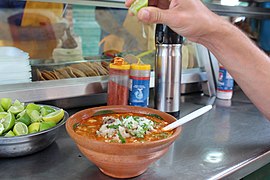Pozole
chile peppers, seasonings | |
| Variations | Blanco, Verde, Rojo |
|---|---|
Pozole (Spanish pronunciation:
Description
Pozole can be prepared in many ways, but all variations include a base of cooked hominy in
The three main types of pozole are blanco (white),.
Pozole is commonly served accompanied by a wide variety of toppings, particularly raw vegetables. Common toppings include chopped onion, shredded cabbage, sliced radish, avocado, limes, oregano, tostadas, chicharrón, and chiles.[2]
Regional customs
Pozole is also considered a festive dish. In Mexico and in

Pozole is a typical dish in various states such as Nayarit, Sinaloa, Michoacán, Guerrero, Zacatecas, Jalisco, and Morelos. Pozole is served in Mexican restaurants worldwide. It is also popular in the cuisine of New Mexico where it is known as posole, and is a common dish among the Puebloan Indigenous peoples residing along the Rio Grande.[6][7]
In the Southwestern United States, a type of field corn (posole corn) is used that differs from hominy. It is considered to be more flavorful and has a firmer texture than hominy which tends to be softer and mushier than posole.[8] The
History
Pozole was mentioned in the 16th century
According to research by the
Gallery
-
White pozole
-
Cooked hominy
-
Dried hominy can be used for pozole, but it must be soaked and cooked.
-
Dried New Mexican blue posole field corn
-
Pozole topped with sliced avocado
-
Green pozole, cooked in Guerrero State fashion
-
Green pozole, with condiments, served in Zihuatanejo (Guerrero)
-
Red pozole, served in Mexico City
-
Red pozole, served inOaxaca de Juárez
See also
- Fricasé
- List of maize dishes
- List of Mexican dishes
- List of soups
- List of stews
- Menudo (soup) – a similar dish made with tripe
- Mexican cuisine
References
- ^ Cookpad: Pozole Blanco
- ^ Bauer, Elise (8 October 2011). "Authentic Pozole Rojo (Red Posole) Recipe". Simply Recipes. Retrieved 13 May 2019.
- ^ Anonymous; Seibert, Sandra; Anonymous; Pharo, Christine; Anonymous; Morethanbeefandtaters; Anonymous; G., Pauline; M., Monica (16 November 2016). "Posole Rojo". Food Network. Retrieved 13 May 2019.
- ^ "Red Posole with Pork". Epicurious. 30 May 2017. Retrieved 13 May 2019.
- ^ "Mexican Pozole". Mexico. Retrieved 13 May 2019.
- ^ Cocking, Lauren (12 February 2017). "A Brief History of Pozole, Mexico's Take on Traditional Stew". Culture Trip. Retrieved 13 May 2019.
- ^ Butel, Jane (11 December 1994). "Sacred Stew : Posole, a Native American corn dish, is served at pueblo festivals, but it can also be sampled in restaurants around Albuquerque". Los Angeles Times. Retrieved 13 May 2019.
- ^ Butel, Jane (11 December 1994). "Sacred Stew : Posole, a Native American corn dish, is served at pueblo festivals, but it can also be sampled in restaurants around Albuquerque". The Los Angeles Times. Retrieved 3 January 2024.
- ^ Manus, Mihio (17 September 2013). "Native American Day at Hopi High" (PDF). Vol. 21, no. 18. The Hopi Tutuveni. Retrieved 3 January 2024.
- ^ "Blue Corn Posole Stew". Rim Journal. Retrieved 3 January 2024.
- ^ a b Pozolli. (n.d.). Nahuatl dictionary. Retrieved 28 August 2012, from http://whp.uoregon.edu/dictionaries/nahuatl/index.lasso
- ^ Bernardino de Sahagún, Florentine Codex: General History of the Things of New Spain (Translation of and Introduction to Historia General de Las Cosas de La Nueva España; 12 Volumes in 13 Books ), trans. Charles E. Dibble and Arthur J. O Anderson (Salt Lake City: University of Utah Press, 1950–1982). Images are taken from Fray Bernardino de Sahagún, The Florentine Codex. Complete digital facsimile edition on 16 DVDs. Tempe, Arizona: Bilingual Press, 2009. Reproduced with permission from Arizona State University Hispanic Research Center.
- S2CID 162825038.
- S2CID 35652641.









